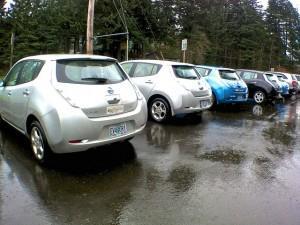 A question that may not receive the attention it merits, as raised in a previous post, is the true environmental value of an electric vehicle (EV)–namely, the carbon and climate impacts of an EV over the course of its full lifecycle. Could it be the case that hybrid vehicles–widely considered a transitional technology to full-fledged EVs–may in fact have less of a carbon footprint? This question has important implications for consumers, auto manufacturers, and policy makers, particularly at a time when hybrid sales continue to rise while those of EVs have not grown as quickly as once anticipated, and for broader debates about whether or not public incentives to encourage EV are effective.
A question that may not receive the attention it merits, as raised in a previous post, is the true environmental value of an electric vehicle (EV)–namely, the carbon and climate impacts of an EV over the course of its full lifecycle. Could it be the case that hybrid vehicles–widely considered a transitional technology to full-fledged EVs–may in fact have less of a carbon footprint? This question has important implications for consumers, auto manufacturers, and policy makers, particularly at a time when hybrid sales continue to rise while those of EVs have not grown as quickly as once anticipated, and for broader debates about whether or not public incentives to encourage EV are effective.
The answer to this question may be more context-dependent than at first glance. Taking into account the “what” and “how” of the EV and its manufacturing process, and how the vehicle is used (long distance versus short distance drives), another important factor is the “where”: where the vehicle is used, and how the electricity powering it is generated.
A new report by the organization Climate Central tackles this question, examining at a state-by-state level the carbon footprints and climate impact of EVs, plug-in hybrid EVs, and gas-powered hybrids. In particular, the study focuses on three major criteria: where you live (and the carbon-intensity of the electricity source); how far you drive (which incorporates both the carbon footprint of the manufacturing process as well as that incurred in driving the vehicle); and what you drive (as every EV and hybrid on the market have different levels of efficiency in converting energy into mileage).
The answers to these questions depend significantly (though not exclusively) on the sources of the electricity powering the vehicle in any given location. For example, the report found that in 11 states, the best EVs had less of a climate impact than any gasoline-powered hybrid vehicles. A characteristic shared by these states is an electricity grid reliant on hydro power (e.g. Washington, Oregon, and Idaho) and/or nuclear power (e.g. Vermont), along with renewable resources. In 18 states (including several heavily dependent on coal for electricity), gasoline-powered hybrid vehicles were more climate-friendly than EVs.
It is noteworthy that these figures are dynamic in nature–and changing as new, cleaner energy sources become more widely used and vehicle technologies continue to mature. For example, the report found that, between 2010 and 2012, the reduction of the carbon footprint of electricity generation (such as through the increase of natural gas and decrease of coal) doubled the number of states from 13 to 32 where EV’s had less of a climate impact than gasoline-powered vehicles. These shifts also changed where certain types of EVs performed more effectively than others in producing fewer emissions. For example, driving an all-electric Nissan Leaf was found to generate fewer emissions (excluding manufacturing emissions) than a hybrid Toyota Prius in 32 states in 2012. At the same time, when total lifecycle emissions (including manufacturing) are considered, this number drops to 13 states. It also found that no EV currently on the market outperformed a gasoline-powered hybrid vehicle in having a lower climate impact over a 50,000 mile driving lifetime, and that over 100,000 miles EVs only outperformed gas-powered hybrid vehicles in four states: Washington, Oregon, Idaho, and Vermont.
What are the implications? One is that the green “value” of an EV rises where the electricity grid is also green. Where EVs perform best, their numbers are spectacular. Not all states have the hydro power resources of some of the best performers, and the future of nuclear energy (also a contributing factor for some states that rate highly) is uncertain. On the other hand, the rising use of natural gas and renewables appears to be greening the grid in some states, thus improving the environmental value of EVs. A second consideration is that improved EV technologies that more efficiently convert electricity into mileage, and more energy and resource-efficient manufacturing processes, will also increase the green quotient of EVs. Though offering somewhat sobering findings of EV performance, this report and its holistic approach are a valuable resource for benchmarking and considering broader strategies for tackling climate challenges.
Image Source: Oregon DOT




